食品专业英语 lesson 9-Lipids
- 格式:pdf
- 大小:265.60 KB
- 文档页数:4

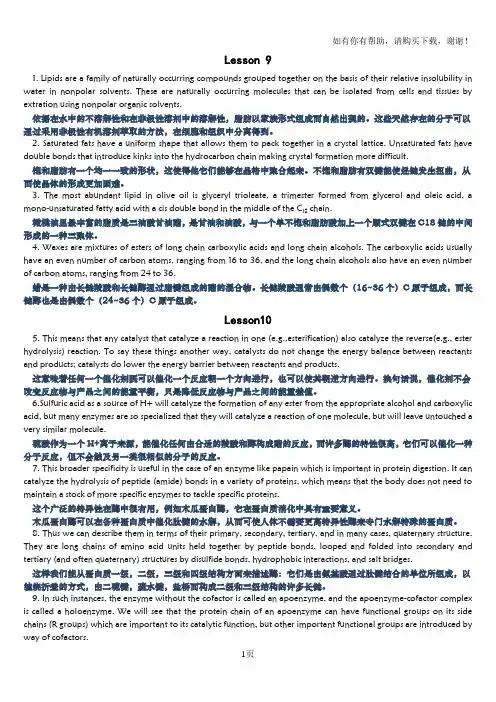
Lesson 91. Lipids are a family of naturally occurring compounds grouped together on the basis of their relative insolubility in water in nonpolar solvents. These are naturally occurring molecules that can be isolated from cells and tissues by extration using nonpolar organic solvents.依据在水中的不溶解性和在非极性溶剂中的溶解性,脂肪以家族形式组成而自然出现的。
这些天然存在的分子可以通过采用非极性有机溶剂萃取的方法,在细胞和组织中分离得到。
2. Saturated fats have a uniform shape that allows them to pack together in a crystal lattice. Unsaturated fats have double bonds that introduce kinks into the hydrocarbon chain making crystal formation more difficult.饱和脂肪有一个均一一致的形状,这使得他它们能够在晶格中聚合起来。
不饱和脂肪有双键能使烃链发生扭曲,从而使晶体的形成更加困难。
3. The most abundant lipid in olive oil is glyceryl trioleate, a trimester formed from glycerol and oleic acid, a mono-unsaturated fatty acid with a cis double bond in the middle of the Cchain.18橄榄油里最丰富的脂质是三油酸甘油酯,是甘油和油酸,与一个单不饱和脂肪酸加上一个顺式双键在C18链的中间形成的一种三聚体。
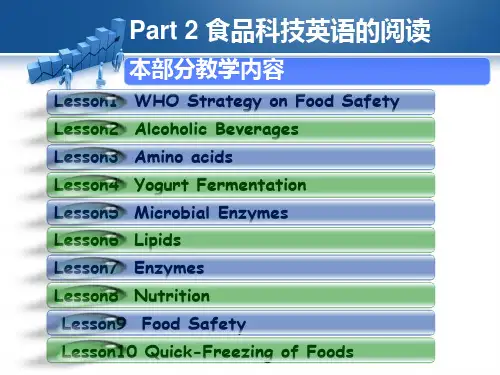
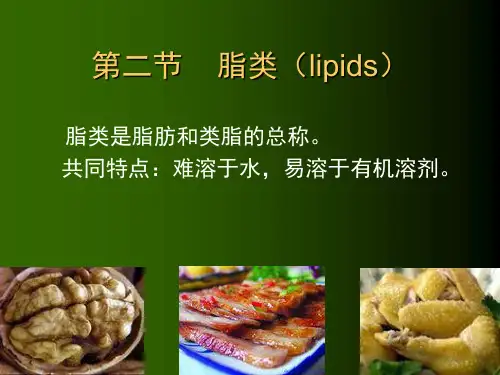
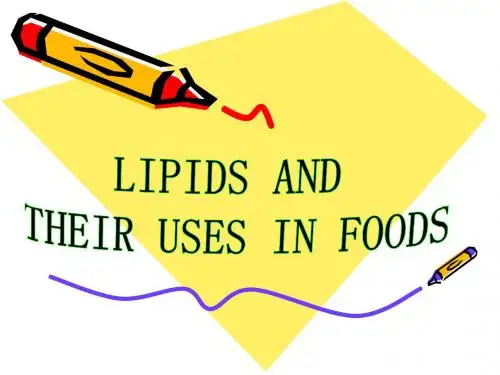
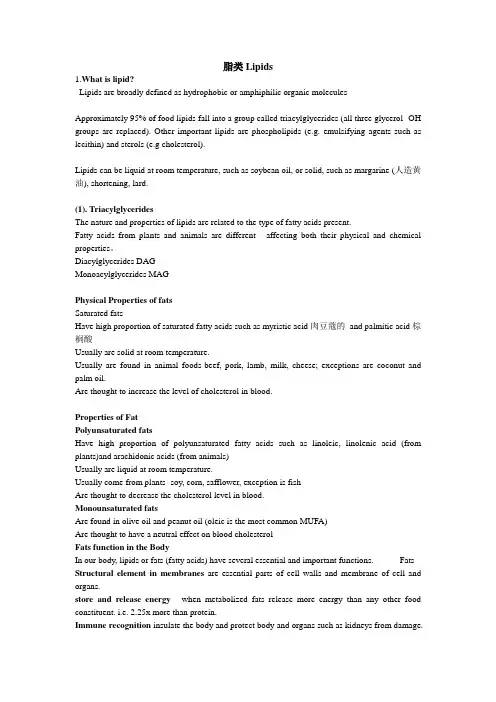
脂类Lipids1.What is lipid?Lipids are broadly defined as hydrophobic or amphiphilic organic moleculesApproximately 95% of food lipids fall into a group called triacylglycerides (all three glycerol -OH groups are replaced). Other important lipids are phospholipids (e.g. emulsifying agents such as lecithin) and sterols (e.g cholesterol).Lipids can be liquid at room temperature, such as soybean oil, or solid, such as margarine (人造黄油), shortening, lard.(1). TriacylglyceridesThe nature and properties of lipids are related to the type of fatty acids present.Fatty acids from plants and animals are different - affecting both their physical and chemical properties。
Diacylglycerides DAGMonoacylglycerides MAGPhysical Properties of fatsSaturated fatsHave high proportion of saturated fatty acids such as myristic acid肉豆蔻的and palmitic acid棕榈酸Usually are solid at room temperature.Usually are found in animal foods-beef, pork, lamb, milk, cheese; exceptions are coconut and palm oil.Are thought to increase the level of cholesterol in blood.Properties of FatPolyunsaturated fatsHave high proportion of polyunsaturated fatty acids such as linoleic, linolenic acid (from plants)and arachidonic acids (from animals)Usually are liquid at room temperature.Usually come from plants- soy, corn, safflower, exception is fishAre thought to decrease the cholesterol level in blood.Monounsaturated fatsAre found in olive oil and peanut oil (oleic is the most common MUFA)Are thought to have a neutral effect on blood cholesterolFats function in the BodyIn our body, lipids or fats (fatty acids) have several essential and important functions. Fats Structural element in membranes are essential parts of cell walls and membrane of cell and organs.store and release energy - when metabolized fats release more energy than any other food constituent. i.e. 2.25x more than protein.Immune recognition insulate the body and protect body and organs such as kidneys from damage.are necessary for the production of various hormones and vitamin D.are essential transport agents for fat soluble vitamins around the body tissues.Enhance food flavorFunction1). Structural element in membranesLipids can be found in many tissues and cells, for example: Membrane is a kind of lipid bilayers which consists of 50-70% Phospholipids, 20-30% Cholesterol and 20% protein2). store and release energyLipids are one of the three main sources of food, along with carbohydrates and proteins. They are responsible for storing energy that animals do not immediately need. If needed, they can produce energy by metabolism at any time.3). Assist in absorption of fat-soluble vitaminsSome lipid-soluble vitamins, such as vitamin A, vitamin D, vitamin E and vitamin K are also belong to lipids. The food fat can help the body to absorb them.4). Immune recognitionlipids can not only insulate heat but also support and protect the viscera(内脏)inside the body, keep them away from damage5). Food sense intensifierLipids stay long in the stomach as compared with glucose and the protein. It takes 4 to 6 hours to digest some food which contain 50 g fat. So, people always feel full.6)enhance food flavorBesides, lipids can ameliorate the sense and the capability of food. For example, deep fried food has a special scent.(2).PhospholipidsPhospholipids are a combination of fats plus phosphate, some forms also contain nitrogen. they are similar to fats.Glycerolphosphate (Lecithin, Cephalin脑磷脂, Lipositol肌醇磷脂, Cardiolipin 心肌磷脂) Lecithin(卵磷脂) is the best known example of a phospholipid. They have a structure based on glycerol but instead of the three hydroxyl groups being combined with a fatty acid,only two are so combined,the third being combined with phosphate linked to choline 胆碱.It is synthesized by both plants and animals, and is found in foods such as egg yolk and soybeans. Sphingolipids (神经)鞘脂类, are a class of lipid containing a backbone of sphingoid bases鞘氨基醇类, a set of aliphatic amino alcohols that includes sphingosine鞘氨醇Function of phopholipids1) Are important components of membrane structure.2) Affect the synthesis of neurotransmitters (such as serotonin (复合胺), acetylcholine, dopamine(多巴胺) and norepinephrine(去甲肾上腺素) in brain。
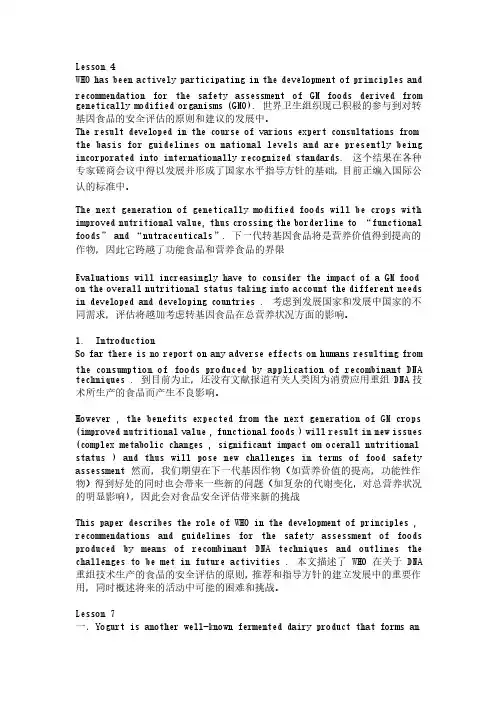
Lesson 4WHO WHO has has been been actively actively actively participating participating participating in in the the development development development of of principles principles and and recommendation for the safety assessment of GM foods derived from genetically genetically modified modified modified organisms organisms organisms (GMO). (GMO). (GMO). 世界卫生组织现已积极的参与到对转世界卫生组织现已积极的参与到对转基因食品的安全评估的原则和建议的发展中。
The result developed in the course of various expert consultations from the basis for guidelines on national levels and are presently being incorporated into internationally recognized standards. 这个结果在各种专家磋商会议中得以发展并形成了国家水平指导方针的基础,目前正编入国际公认的标准中。
认的标准中。
The next generation of genetically modified foods will be crops with improved nutritional value, thus crossing the borderline to to ““functional foods foods”” and and ““nutraceuticals nutraceuticals””. . 下一代转基因食品将是营养价值得到提高的下一代转基因食品将是营养价值得到提高的作物,因此它跨越了功能食品和营养食品的界限Evaluations will increasingly have to consider the impact of a GM food on the overall nutritional status taking into account the different needs in developed and developing countries . 考虑到发展国家和发展中国家的不同需求,评估将越加考虑转基因食品在总营养状况方面的影响。

Lesson 9 lipids一、new wordssolubility n 溶解度,溶解性solubilize v 溶解solube adj 可溶解的solute n 溶质solution n 溶液solvent n 溶剂nonpolar solventpolar solventester n 酯⏹triester n 三酯⏹triesters of glycerol 甘油三酯glycer(o)- 甘油⏹glycerol 甘油,丙三醇⏹Triacylglycerol 三酰基甘油carboxylic 含羧基的,⏹carboxylic acid羧酸aqueous adj.水的,含水的,水成的⏹aqueo- 水合的,由水衍生的⏹aqui- 水⏹aquiculture 水产养殖cis geometry 顺式构型trans geometry 反式构型cholesterol 胆固醇saturated 饱和的unsaturated 不饱和的saturated fatty acid 饱和脂肪酸monounsaturated一元不饱和的polyunsaturated 多元不饱和的⏹mono- 单,一⏹poly- 多,聚二、textLipids are a family of naturally occurring compounds (grouped together on the basis of their relative insolubility in water and solubility in nonpolar solvents. )脂类是由相对不溶于水、可溶于非极性溶剂的天然化合物形成的一个家族。
These are naturally occurring molecules that can be isolated from cells and tissues by extraction using nonpolar organic solvents.nonpolar organic solvents非极性溶剂它们可以通过非极性溶剂的萃取作用从细胞和组织中获得。

电子出版物数据中心中国轻工业出版社出品京新出音[2010]419号ISBN 978-7-89991-109-9高等学校专业教材食品专业英语文选(第二版)许学勤主编目录•Lesson 1 Food Industry •Lesson 2 Water•Lesson 3 Carbohydrates •Lesson 4 Proteins•Lesson 5 Lipids•Lesson 6 Vitamins and Minerals •Lesson 7 Food Additive •Lesson 8 Food Microbiology •Lesson 9 Fermentation Glossary Glossary Glossary Glossary Glossary Glossary Glossary Glossary Glossary•Lesson 10 Physical Properties of Foods•Lesson 11 Food Dispersions•Lesson 12 Food Preservation•Lesson 13 Food Processing•Lesson 14 Unit Operations in Food Processing •Lesson 15 Food Packaging•Lesson 16 Thermal Treatment and Thermal Processing •Lesson 17 Food Concentration•Lesson 18 Food Dehydration and Drying Glossary Glossary Glossary Glossary Glossary Glossary Glossary Glossary Glossary•Lesson 19 Food Freezing•Lesson 20 Extrusion Cooking•Lesson 21 Membrane Separation•Lesson 22 Meat and Meat Products•Lesson 23 Milk and Milk Products•Lesson 24 Poultry and Eggs•Lesson 25 Principles of Baking•Lesson 26 Confectionery and Chocolate Products •Lesson 27 Fruit Juices Glossary Glossary Glossary Glossary Glossary Glossary Glossary Glossary Glossary•Lesson 28 Beverages•Lesson 29 Food Safety•Lesson 30 Hazard Analysis and Critical Control Points •Lesson 31 Good Manufacturing Practice (GMP)•Lesson 32 Sanitation in Food Plant•Lesson 33 Food Quality•Lesson 34 Shelf-life of Food Products Glossary Glossary Glossary Glossary Glossary Glossary Glossary。

电子出版物数据中心中国轻工业出版社出品京新出音[2010]419号ISBN 978-7-89991-109-9高等学校专业教材食品专业英语文选(第二版)许学勤主编目录•Lesson 1 Food Industry •Lesson 2 Water•Lesson 3 Carbohydrates •Lesson 4 Proteins•Lesson 5 Lipids•Lesson 6 Vitamins and Minerals •Lesson 7 Food Additive •Lesson 8 Food Microbiology •Lesson 9 Fermentation Glossary Glossary Glossary Glossary Glossary Glossary Glossary Glossary Glossary•Lesson 10 Physical Properties of Foods•Lesson 11 Food Dispersions•Lesson 12 Food Preservation•Lesson 13 Food Processing•Lesson 14 Unit Operations in Food Processing •Lesson 15 Food Packaging•Lesson 16 Thermal Treatment and Thermal Processing •Lesson 17 Food Concentration•Lesson 18 Food Dehydration and Drying Glossary Glossary Glossary Glossary Glossary Glossary Glossary Glossary Glossary•Lesson 19 Food Freezing•Lesson 20 Extrusion Cooking•Lesson 21 Membrane Separation•Lesson 22 Meat and Meat Products•Lesson 23 Milk and Milk Products•Lesson 24 Poultry and Eggs•Lesson 25 Principles of Baking•Lesson 26 Confectionery and Chocolate Products •Lesson 27 Fruit Juices Glossary Glossary Glossary Glossary Glossary Glossary Glossary Glossary Glossary•Lesson 28 Beverages•Lesson 29 Food Safety•Lesson 30 Hazard Analysis and Critical Control Points •Lesson 31 Good Manufacturing Practice (GMP)•Lesson 32 Sanitation in Food Plant•Lesson 33 Food Quality•Lesson 34 Shelf-life of Food Products Glossary Glossary Glossary Glossary Glossary Glossary Glossary。

词汇第一课(一)基本The characteristics about the Food English Sci-Technological Thesis英语食品科技论文的特点Academic thesis 学术论文Experiment:Research report, 实验型Observation,survey: Investigation report 观测型Theory:Mathematical thesis, 理论型Dissertation 学位论文Bachel or’s dissertation 学士论文Master’s dissertation 硕士论文Doctor’s dissertation 博士论文Acknowledgements , References and Appendix 感谢、参考文献和附录Introduction 引言、前言或介绍Materials and Methods 材料与方法Results and Discussion 结果与讨论Conclusions 结论goal 目的review 研究背景your work 要解决的问题experimental methods 实验方法type of experimental design 试验设计number of replications 重复次数statistical analysis 统计分析equipment 仪器(二)缩略词1 述语、组织、团体名称:LC =lethal concentration 致死浓度EAA =Essential amino acids 必需氨基酸DH = degree of hydrolysis 水解度DNA =deozyrebonucleic acid 脱氧核糖核酸USDA=US Department of Agriculture 美国农业部IFT=Institute of Food Technologists 食品科技协会CEO=chief executive officer 总经理2 数字+度量衡单位词15ft (foot\feet)50rpm (revolutions per minute)cal (calorie) 卡C(centigrade)摄氏温度etc=et cetera=and others(等物)et al.=et alii=and others(等人)i.e.=id est=that ise.g.=exampli gratia=for example+plus 加号;正号-minus 减号;负号±plus or minus 正负号×is multiplied by 乘号÷is divided by 除号=is equal to 等于号%per cent 百分之…℃degree Celsius /centigrade摄氏度(1) Terminology 科技术语的翻译Compound word 合成词end point 终点standard solution 标准溶液titration error 滴定误差buffer solution 缓冲溶液Polysemy 多义词Concentration 集中,集合,专心→浓缩,浓度Derivative 派生词:加词缀构成新术语alkaline 碱性的alkalinity碱度Spectrophotometer 分光光度计Condenser 冷凝器Subordination 分清主从法Diction 选词用字法Amplification & Omission 增字法与省略法Conversion 转换法Inversion 词序调整法Division 长句拆译法Subordination 分清主从法The food technologist can usually recognize fats[when he sees them] because they are quite different [both in their physical properties and in their chemical composition ]from the other two main food constituents: carbohdrate and protein.当食品科学工作者看到脂肪时,通常可以确认它们,因为不论在物理性质和化学组成上,脂肪都与另外两种主要食品组成成分(碳水化合物和蛋白质)不同。
第三章脂类Lipids脂类(lipids)化合物脂类是脂肪、磷脂、类固醇等类化合物的总称¾脂类不溶于水,可溶于非极性溶剂¾脂类是生物膜的主要成分¾脂肪氧化时产生的能量大约是糖的二倍¾生物表面的保护层/保持体温/¾生物活性分子抹香鲸:深海狩猎者1.头占体重1/3;2.头部90%重量是脂肪,约4吨;3.头部脂类37º是液体,31º结晶;4.以深海鱿鱼为食,捕食时可下潜1000~3000 m。
5.是生物与环境适应,生物体结构与功能统一的范例。
第三章脂类Lipids1.脂肪酸:脂类的重要结构成分2.作为能量储备的脂类3.作为膜结构成分的脂类4.作为生物活性分子的脂类5. 脂蛋白6.脂类的研究方法1. 脂肪酸Fatty acid①大约有100多种②C原子数几乎都是偶数③多数为12-24个C,最常见16和18C④双键数目为0-4个,双键几乎都是顺式反式脂肪酸主要存在于奶油类、煎炸类、烘烤类和速溶类等食品中1.1.脂肪酸的命名nomenclature 18-carbon,C-1 being the carboxyl carbonone double bond between C-9 and C-10another between C-12 and C-13C-cis T-tran18:2Δ9c,12c 顺,顺-9,12-十八烯酸(亚油酸)1.2.人体必需脂肪酸-亚油酸,亚麻酸Essential fatty acids①Linoleic acid 亚油酸顺-9,12-十八碳二烯酸18:2 △9c,12c是ω-6PUFA(多不饱和脂肪酸)家族成员,能转化成花生四烯酸,能明显降低血清胆固醇水平,缺乏易导致皮肤病1.2.Essential fatty acids富含omega-3脂肪的克隆猪1.3.酸呈蜡状,不饱和脂肪酸为不饱和脂肪酸大多为顺式;链越长,双键越多,熔点2.1.作为能量储备的脂类-三酰甘油脂:醇+ FA脂肪酸油脂,脂肪,中性脂,三酰甘油,甘油三酯是甘油和三个脂肪酸形成的三酯;不溶于水;自然界中的油脂大多为混和酯。
lesson 5 lipids 脂类fats and fats-like substances known as lipids are soluble in organic solvents such as chloroform,but are nonpolarand therefore relatively insoluble in water. 被称为脂类的脂肪和脂肪类物质在有机溶剂如氯仿中是可溶的,但非极性因此相对不溶于水。
like carbohydrates,lipids are composed principally of carbon,hydrogen and oxygen,but they may also contain other elements,particularly phosphorus and nitrogen. 如糖类,脂类主要由碳,氢和氧,但它们也可以包含其他元素,特别是磷和氮。
also lipids are not composedof repeating subunits and hence are not polymers.脂质组成重复亚基和因此是不是聚合物。
we shall consider four classes of lipids here fatty acids,fats,phospholipids and steroids.我们应考虑四个类别的脂类脂肪酸,脂肪,磷脂和类固醇。
fatty acids 脂肪酸contain the carboxyl group(-COOH),attached to a long hydrocarbon chain. 含有的羧基(-COOH),连接到一个长烃链。
there are many different fatty acids. 有许多不同的脂肪酸。
they vary in the number of single or double carbon-to-carbon bonds,and in the length of the hydrocarbon chain.他们各有不同的数的单或双碳- 碳键,和在烃链的长度。
Lesson 9 Lipids1.Lipids are a family of naturally occurring compounds grouped together on the basisof their relative insolubility in water and solubility in nonpolar solvents.脂质是一类天然化合物家族,其在水中具有不溶解性和在非极性溶剂里具有溶解性。
2.These are naturally occurring molecules that can be isolated from cells and tissuesby extraction using nonpolar organic solvents. 这些天然存在的分子可以通过采用非极性有机溶剂抽屉的方法,在细胞和组织中分离得到。
3.There are two classes of lipids: i) those with ester linkage s that can be hydrolyzed,for example, fats and waxes; ii) those without ester linkages and so cannot by hydrolyzed, for example, cholesterol and steroid s. 脂质分为两类:酯键可以水解的,例如,脂肪和蜡; 没有酯键即不能水解的,例如,胆固醇和类固醇。
4.Fats and oils are triacylglycerols. 脂肪和油脂都是三酰甘油。
5.They are triesters of glycerol (probane-1,2,3-triol) with three long chaincarboxylic acids. 它们是甘油用三个长链羧酸连接成三个酯健。
6.Reaction with aqueous sodium hydroxide yields glycerol and the three fatty acids.用氢氧化钠水解后可产生甘油和三个脂肪酸。
7.Fatty acids are usually unbranched and contain an even number of carbon atoms,usually from 12 to 20. 脂肪酸通常是没有分枝的,包含12 到20个碳原子。
8.If there are any double bonds, they tend to have cis geometry. 如果存在双键,它们趋向存在顺异构体。
9.Fats containing one double bond are monounsaturated and those with more thanone double bond are polyunsaturated. 含有一个双键的脂肪是单不饱和脂肪酸,含多个双键结构的是多不饱和脂肪酸。
10.Saturated fats have a uniform shape that allows them to pack together in a crystallattice. 饱和脂肪酸具有一个相同的形式,可以包裹在一个晶体结构中。
11.Unsaturated fats have double bonds that introduce kinks into the hydrocarbonchain making crystal formation more difficult. 不饱和脂肪酸具有双键,将双键裹到(碳氢化合物)烃链晶体形式里难度更大。
12.This is why saturated fats have higher melting points and are solids at roomtemperature compared to unsaturated fats that tend to be liquids (oils). 这就是为什么饱和脂肪熔点更高, 在室温下是固体,相对而言不饱和脂肪在室温下是液体。
13.The most abundant lipid in olive oil is glyceryl trioleate, a triester formed fromglycerol and oleic acid, a mono-unsaturated fatty acid with a cis double bond in the middle of the C18 chain. 橄榄油有丰富的三油酸甘油酯, 由甘油和油酸,单不饱和脂肪酸形成三酯,其中单不饱和脂肪酸的C18链中间有一个顺式双键。
14.Waxes are mixtures of esters of long chain carboxylic acids and long chainalcohols. 蜡是长链羧酸和长链醇的酯质类混合物。
15.The carboxylic acids usually have an even number of carbon atoms, ranging from16 to 36, and the long chain alcohols also have an even number of carbon atoms,ranging from 24 to 36. 这种羧酸通常有16至36个碳原子,长链醇也含24至36个碳原子。
Fats and Oils脂肪和油脂1.The triesters of fatty acids with glycerol (1,2,3-trihydroxypropane) compose theclass of lipids known as fats and oils. 脂肪酸和甘油三酯组成的类脂类被称为脂肪和油。
2.These triglycerides (or triacylglycerols) are found in both plants and animals, andcompose one of the major food groups of our diet. 这些甘油三酯类(或叫三酰基甘油)存在植物和动物中,构成了我们食物里的主要成分。
3.Triglycerides that are solid or semisolid at room temperature are classified as fats,and occur predominantly in animals. 这些甘油三酸酯在室温下如果是固体或半固体就被分类叫脂肪,一般主要存在动物体内。
4.Those triglycerides that are liquid are called oils and originate chiefly in plants,although triglycerides from fish are also largely oils. 那些液体状的甘油三酯被称为油,主要来源于植物,虽然鱼体内的甘油三酯也大多是油。
Fatty Acids脂肪酸1.The common feature of these lipids is that they are all esters of moderate to longchain fatty acids. 这种脂类的共同特点是所有都是相对于长链脂肪酸的中等酯类。
2.Acid or base-catalyzed hydrolysis yields the component fatty acid, some examplesof which are given in the following table, together with the alcohol component of the lipid. 酸或碱催化水解产生脂肪酸成分和醇类,其中一些例子列在下面的表中。
3.These long-chain carboxylic acids are generally referred to by their common names,which in most cases reflect their sources. 这些长链羧酸一般的命名原则能反映出其来源。
4.Natural fatty acids may be saturated or unsaturated, and as the following dataindicate, the saturated acids have higher melting points than unsaturated acids of corresponding size. 天然的脂肪酸可以饱和的或者不饱和的,并且下面资料表明,饱和脂肪酸与相同大小的不饱和酸比较,熔点的更高。
5.The double bonds in the unsaturated compounds listed on the right are all cis (orZ). 不饱和的脂肪酸里的双键列在右边,全是顺式结构(或Z结构)。
6.The higher melting points of the saturated fatty acids reflect the uniform rod-likeshape of their molecules. 高熔点的饱和脂肪酸的分子表现为棒状的相同结构。
7.The cis-double bond(s) in the unsaturated fatty acids introduce a kink in their shape,which makes it more difficut to pack their molecules together in a stable repeating array or crystalline lattice. 不饱和脂肪酸里顺式双键有一个扭结的结构,使这些分子一起被包裹到一种稳定的重复结构或晶体格子里难度更大些。
8.The trans-double bond isomer of oleic acid, known as elaidic acid, has a linearshape and a melting point of 45 ºC (32 ºC higher than its cis isomer). 油酸的反式双键异构体,即众所周知的反油酸具有一个线性结构,熔点是45 ºC(顺式结构是32 ºC)。